Sara Jayne Townsend's Blog, page 41
January 23, 2012
Imaginary Friends: Barbara Kellyn
Today I am pleased to be interviewing romance writer Barbara Kellyn on my blog, whose latest novel MORNING MAN will be released later this year by Lyrical Press.
Welcome, Barbara!
SJT: When did you first know you were destined to be a writer?
BK: I've always been a creative person. When I was growing up, I used both drawing and writing in my storytelling and at one time, aspired to be either an author of picture books or work in advertising so I could combine both talents. By the time I got to college to follow my chosen career path in advertising, I realized that it was the written word that best expressed my ideas.
SJT: Who would you cite as your influences?
BK: Certainly, my family has been my greatest influence as they have always nurtured and encouraged my creativity side. I wouldn't say I have a favourite writer, but I admire anyone who can tell a great story, whether in a book, on stage or on screen. If you look at my shelves, you'll see that the greatest number of books I own are by Jennifer Crusie, who to me, perfected contemporary romantic comedy. I'd love to follow in her footsteps.
SJT: What do you like to do when you're not writing?
BK: I'm a single mom as well as a business owner, so most of my non-writing hours are either spent hanging out with my kids or working. For fun and "me time" I enjoy going for a brisk walk, cooking, or going out to try new restaurants. Other than writing, I find that listening to the music I love is also very harmonizing (pardon the pun) and I am uplifted by live concert experiences. All in all, I think my life is pretty well balanced.
SJT: What advice would you pass on to beginner writers that you wish someone had told you when you were first starting out?
BK: To be a writer, you'll have to rely on both your right brain (emotion, expression) and left brain (logic, sequencing) in order to be successful. When you start out, you think you'll be able to just sit down and the story will pour out of you. It will, but in all likelihood, it won't be fit for consumption until you go back and analyze every word. You must ensure the story hits all the right posts; it has a suitable amount of tension; it builds into a climax; and that the characters and dialogue ring true. That's hard and "unnatural" work for most right-brain types; I know it is for me.
SJT: Your first novel, THE COMPANY SHE KEEPS, is set in an advertising agency. Have you drawn on any real-life work experiences in the workplace to embellish this novel?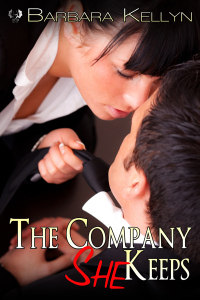
BK: As I mentioned, advertising was my chosen career path and it's the field I continue to work in over twenty years later. I have been part of my fair share of highly creative, colorful and certainly, dysfunctional workplaces and let me tell you, there's plenty of inspiration in each one of them. There is no shortage of zany incidents and quirky characters in such environments and I'm fortunate to have experienced so much that I've been able to amalgamate it into fodder for fun-to-read fiction.
SJT: You claim to be a pop culture junkie. What's your favourite trashy TV show?
BK: Hey, one girl's trashy is another girl's treasure! I have quite a few TV guilty pleasures. I've been watching The Young & The Restless faithfully since junior high. I get a kick out of TLC's reality shows like Sister Wives, Say Yes to the Dress and Extreme Couponing. But I have to admit, this year I got addicted to Swamp People, about gator hunters in the Louisiana Bayou. I dare anyone to watch it once and not get completely hooked.
SJT: What can you tell us about your forthcoming release, MORNING MAN?
BK: I'm so excited about MORNING MAN! It's about a morning show duo at a fledgling radio station. Their sizzling on-air chemistry sparks smoldering attraction outside the studio – even though our heroine has sworn off falling for the radio jocks she works with after a string of failed relationships. On top of this, because our duo's undeniable sexual tension is driving listeners to tune in, the station manager makes them pledge to stay out of bed until after the summer ratings period ends.
SJT: When it comes to starting a new writing project, would you describe yourself as a meticulous planner, or a 'seat-of-the-pantser'?
BK: I'd say I am a little of both. THE COMPANY SHE KEEPS was a personal challenge sparked by NaNoWriMo, which notoriously champions pantsing over planning: a 30-day deadline, a 50,000-word goal, a blank screen and…. go! It was an amazing accomplishment, but took a year of refining afterwards to get it fit for submission.
On the other hand, MORNING MAN was a little more planned because I was more educated about the process. I started with a rough plot outline and main character sketches, but even that was loosely organized so I still had some flexibility as the story evolved in my head. However, that book went much smoother: I went from first written word to edited manuscript in a phenomenal six weeks! Everything just clicked. Because of that, my latest work in progress has followed more in MORNING MAN's footsteps. The pre-planning seems to work for me, but the story development stays more compelling when I allow myself the freedom to "pants" it. Nothing beats being surprised and delighted by my characters as we go along.
Thank you, Barbara,for being my guest today!
Barbara Kellyn writes the kind of stories that she loves to read: contemporary romantic comedies fraught with amusing complications and taut sexual tension between a likeable heroine worth rooting for and an alluring hero worth the trouble of falling fo.
A lifelong storyteller in one form or another, Barbara is an accomplished, award-winning writer. She also enthusiastically admits to being a pop culture junkie (you definitely want her on your celebrity quiz team), with a weakness for tabloid TV, timeless chick flicks, sexy soaps and any smartly-written show, book, movie or Tweet that makes her laugh out loud.
Barbara thanks her lucky stars that she is living out the kind of blissful existence that her characters can only dream about getting to before the last page. To learn more, visit her website at www.barbarakellyn.com.








January 21, 2012
Can We Start Again, Please?
2012 has not got off to a good start. My NetBook dying on New Years' Day was the first bad portent. A sore throat the following day was the next.
This had turned into a cough by the time I went back to work. If like me you have asthma, coughs are never good. They take ages to go, and often turn into something far nastier.
After two weeks of struggling along and coughing like a plague victim, I went to see the doctor, who decided I had a chest infection. She prescribed antibiotics and signed me off work for the rest of the week. This was on Monday of this week. So I have spent the majority of this week cocooned on the sofa feeling sorry for myself. And playing Dragon Age, my latest video game obsession, which was the only thing I found I could concentrate on and at least it distracted me from thinking about how rubbish I was feeling.
I am not a good patient. I hate being ill. I hated the fact I was coughing so hard, I couldn't sleep, I couldn't focus on anything, and I had to put ordinary activities on hold. The antibiotics, although helping clear up the infection, have side effects, the most annoying of which is stomach pains. I also developed a constant niggling ache in my lower back, which I suspect is caused by straining some muscle or other through coughing too hard.
Now we are at the weekend, I have to say I am feeling a lot better. I am no longer waking up in the night having coughing fits. The back pain seems to be easing. If I eat something with the antibiotics – even if it's just a couple of biscuits – the stomach pains aren't as bad. The coughing is still there, but not as frequent, or as violent, as it was.
Frankly I'm tired of being ill, and I am keen to get back into the usual routine. I'm going back to work on Monday. I aim to do some writing this weekend. I'd even like to get back to going to the gym.
I would like to write off the entire month of January, as I got nothing accomplished during it. Well, I made quite a lot of progress in Dragon Age, and even managed to score a couple of trophies. But I'm not sure that counts.








January 18, 2012
What's In A Name?
(Cross-posted on the
"A rose by any other name would smell as sweet," Juliet says to Romeo, arguing against the notion that he has the name of a rival family.
I have to disagree with her on this point. Names are important. It's why I still insist on being Ms Townsend, even after getting married, and why I don't write under a pseudonym. I've been Sara Jayne Townsend for 42 years, and I'm not about to change now. I've played about with hyphenating the two names, and had a very brief spell, aged about 13, when I decided I preferred 'Sarah' to 'Sara'. But ultimately this is my name, and it might not be very special or significant, at least to anyone else, but it's mine, and it's part of what makes me who I am. With a different name, I'd feel like a different person.
The same can be said for character names. They must be chosen very carefully. I'm writing in the 'real' world, on the whole, so perhaps have an easier job than SF and fantasy writers, who have to make up names. But even so, much thought goes into character names. It's why a book of baby names lives on my shelf of writing reference books, in spite of the fact I am well known as a person with no interest whatsoever in having children.
Sometimes characters seem to name themselves, but the names that attach themselves to the characters conjure up connotations and aspects of how that character is developing in my mind. The young protagonist of SUFFER THE CHILDREN, Leanne, seemed to name herself without a great deal of thought from me. It's a name that to me conjures up connotations of a tough but vulnerable person. It's a fairly modern name, so it suited a young person. The character Carrie, on the other hand, I purposefully named after a Stephen King novel, because I wanted to pay homage to a writer who has provided a great deal of inspiration to me for most of my writing life.
As for naming the boys, I have to say that when I write men – and I am of the opinion I'm not terribly good at writing men – I do tend to write about my ideal men, as I'm sure a lot of writers do. However, my concept of the ideal man is sensitive, intelligent, introverted and geeky, which pretty much describes Simon in SUFFER THE CHILDREN. The aggressive Alpha male is not a turn on for me. Give me a geek any day.
My first two serious adolescent crushes – the kind when you start writing their names in hearts all over the cover of your school exercise books – were, firstly Mark Hamill (I first saw Star Wars a month before my 13th birthday, and it was a revelation – up until then boys had largely been an alien species for me), and shortly afterwards, Simon Le Bon, when I first got into Duran Duran. So the names Simon and Mark have, to me, always suggested desirable men. No real surprise, then, that the hero of my first published novel is called Simon, and the hero of my current WIP horror novel is called Mark.
It's difficult, though, with names, especially when you're going with real-life ones, because sometimes people you know make the assumption that if you use their name in a book, you are basing the character on them. The horror WIP has characters called Helen, Mark and David. There are people with these names in the T Party, but I can say, in all honesty, that none of my characters are based on anyone in the writing group. If I do base characters on people in real life, I don't give them the same name as the real life person. For instance, the character of Jonathan in DEATH SCENE is based on a real person. But that person's name isn't Jonathan. And that's all I'm prepared to say on that subject.
Where do you get inspiration from for your character names?








January 16, 2012
Monday's Friend: Diane Dooley
Today I am pleased to welcome Diane Dooley to my blog.
The Reading Child; The Writing Adult
By Diane Dooley
Thanks, Sara-Jayne, for inviting me to your blog. I'll try not to mess the place up.
I'm a regular reader of this blog and have been enjoying S.J.'s ongoing series of posts on 'My Life in Books,' in which she chats about some of her favorite books while growing up. We have a few authors in common, namely Enid Blyton and Roald Dahl. Today I'd like to tell you about three books I read when I was young that have been an influence on my writing as an adult.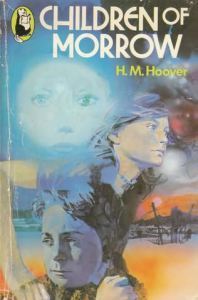
First is 'Children of Morrow,' by H.M. Hoover (Published 1973). This was probably the first science fiction I had ever read. It's about two children living in a post-apocalyptic society, in a cruel and patriarchal community that worships the nuclear bomb. This book riveted me. I read it over and over and over. It wasn't a happy book; quite the opposite. The children were hated and abused, they were vilified for being different and eventually hunted. I wonder if it would even get published today? It was that depressing. But I loved it. No wonder that my writing today is on the dark side.
Next is 'The Twelfth Day of July' by Joan Lingard (Published 1970). Kevin and Sadie are two teenagers growing up in Northern Ireland during the Troubles. One is Catholic; one is Protestant. They're supposed to be enemies, but instead they meet, get to know each other and eventually start a romantic relationship. I grew up in the west of Scotland where there was also a terrible divide between Catholics and Protestants, so this book helped show me that it didn't have to be that way. And to this day I adore love stories where two people from very different worlds get to live happily ever after against all the odds. I write them, too.
Finally, we have 'The Secret Diary of Adrian Mole' by Sue Townsend (Published 1982). Adrian is a pompous, annoying and adorable teenager, who is trying to cope with the breakdown of his parents' marriage, falling in love for the first time and getting his poetry repeatedly rejected by the BBC. It was so darn funny! It made me smile and giggle and realize that perfect people just aren't funny. It was his flaws and earnestness that made Adrian such a lovable guy to read about. To this day I prefer deeply flawed characters and trying to make readers laugh, just as this book made me laugh.
Did any of you read any of these books? Or was there another that made a huge impact on you? Please leave a comment to be entered for a random drawing for an e-copy of my book, BLUE GALAXY.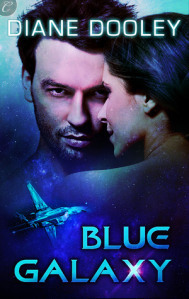
Incidentally, or rather not, Blue Galaxy is set in a desperate future, where an evil dictator is slowly bringing humanity to its knees. It's a love story, where two people who should never have met fall in love. And the characters are flawed, funny people who love to zing lines of dialogue at each other. What I write is deeply influenced by what I like to read, including all the great books I read when I was much younger. Funny how that works, ain't it?
Diane Dooley writes science fiction, romance and horror, sometimes all in the same story. You can track her down on her blog, on FaceBook or on Twitter.








January 11, 2012
IT Fail
(Cross-posted from WriteClub)
My little NetBook has died. I mourn its passing. I have to come to rely on it completely in the last couple of years. Not only is it my lifeline during my early-morning Starbucks writing sessions, but I also take it on holiday with me. This year it's been to Egypt, where it witnessed the birth of my new horror WIP. It's also been to New York.
I used to do all my writing on my Dell laptop, which sits docked in my Writing Corner. When I decided to be more disciplined in my writing, my husband suggested we get a NetBook, which was much more portable than the laptop. It's fair to say it revolutionised my writing habits.
The Dell laptop is seven years old, and has been getting decidedly slower and clunkier of late. In fact, when I turn it on I have to go away and do something else for twenty minutes, because it takes that long to think about things. So my main gift this past Christmas was a shiny new laptop running Windows 7. It's lightning fast in comparison to the old one.
But, on New Years' Day, the NetBook died. Literally. In the morning it was working fine; I went back to it a few hours later and tried to wake it from its sleep mode, and couldn't. Continuous restarts failed to get me past a black screen with the words 'failed to find operating system' on it. Apparently this means the hard drive has failed. Getting it fixed is going to cost almost as much as a new machine, and even then there's no guarantee we can retrieve any of the files.
I am, on the whole, pretty good at backing up. I transfer all my writing files between the laptop and the NetBook regularly, and every so often back them up onto the desktop PC as well. However, I'm not so diligent about doing this every day. I'd made a start on editing my short stories for the collection, and hadn't copied them over anywhere. This wasn't the end of the world, as I was able to retrive my Stumar Press editor's copies from his email to me, and it just meant having to do them again. However, when I had my novel critique session for the second Shara book, I made notes as we went along on the NetBook. That I hadn't copied anywhere, and so it's lost forever. I do have the hard copies from my critiquers, but the idea of making a document with my own notes was so I would have an easy-to-access precis of what I need to fix in the next draft. Bummer.
What's most inconvenient, however, is not having the NetBook to carry to my writing sessions. That I really miss. Not wanting to expose my shiny new laptop to the hazards of Central London, I have had to resort to hauling out the old Dell again and taking that into London with me for my writing mornings. It's very heavy. And as I said before, it takes a long time to warm up.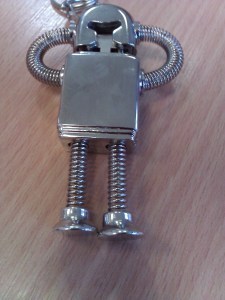
However, I have learned my lesson with regard to backing up. This little guy in the picture was one of my stocking stuffers. I call him Robbie. He's a USB flash stick with 8GB of memory. I have copied over all my WIPs onto him, and I carry him around everywhere. Every time I write more words, I copy them over straight away.
Having just forked out quite a lot of money on a new laptop, replacing the NetBook has to wait a while. In the meantime, I have to either get used to lugging the ancient laptop around, or I need to rearrange my writing schedule to give myself more time to write at home. Because I really don't want to use the IT fail as an excuse to not write. Much as it's made me realise how much I rely on technology, that would be a poor excuse indeed.








January 9, 2012
Monday's Friend: Griffin Hayes
Today I am pleased to welcome horror writer Griffin Hayes to my blog. Griffin interviewed me on his blog last month, so I am reciprocating by interviewing him today. Welcome, Griffin.

SJT: When did you first know you were destined to be a writer?
GH: I came to writing in a roundabout way. I majored in History in University and all my research papers were finished and edited several times weeks before the due date. That should have been my first clue. I also tried writing my first novel at fifteen and didn't get more than a page into it before I realized I had no idea what I was doing. The more people that email to ask me when my next book is being released, the more I know I'm right where I should be.
SJT: Can you tell us a little about your published novel?
GH: Part mystery, part horror thriller, MALICE follows a 17-year-old goth named Lysander Shore as he begins to unravel a series of grisly murders made to look like suicides. Something is getting inside people and making them do unspeakable things. Lysander meets a girl named Samantha Crow, maybe the one person who believes he may be onto something. Together they peel away the layers to a mystery that leads all the way back to a Witch's harrowing execution in the 17th century.
SJT: Have you ever been inspired to put people you know in real life in your books?
GH: My characters are usually a composite of several people I know. Only one is based completely on a friend of mine. I won't say which character or who the friend is though. Often I develop a mental image of the character and their traits and then cut pictures out of magazines of people who look like them. That way I always have a quick reference on days when my brain's feeling sluggish.
SJT: What do you think is the enduring appeal of horror?
GH: People like to have the crap scared out of them. I think it's really that simple. Also, with horror, the audience knows it isn't real and can sit back and appreciate the ride for what it is.
SJT: Stephen King wrote lots of books about kids and was never considered a YA writer. Nowadays, it seems if anyone writes a book with a protagonist under 18, it's billed as YA. Do you consider your novel MALICE to be a YA novel?
GH: Not really. But unfortunately, as you said, stories with teenage protagonists are labelled YA right away. Some agents and publishers I approached suggested that I make the characters in MALICE older, but that would have destroyed the themes and messages I was aiming for. Truth is, I didn't have anyone but myself in mind when I wrote MALICE. I write for me. Sounds selfish I know, but I figure if I'm bored, my audience will be bored.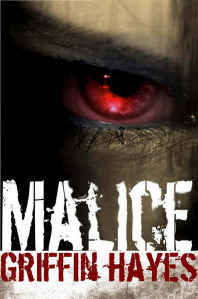
SJT: What are your views on the e-book revolution? Do you think e-books will kill off print books, as many people seem to fear?
GH: Perhaps eventually. Right now we're seeing a repeat of the Beta-VHS wars. Two competing formats. At some point there will be a clear winner. I can't imagine that winner will be print books, but they're here for now.
SJT: Your website mentions your journey from the submission treadmill to independent publishing. Do you think that e-books are making it easier for authors to go down this route?
Oh for sure. I'd never considered self-publishing before e-books started making a splash and mostly because I didn't like the idea of filling my house with thousands of books I needed to sell myself. All that running around would have taken too much time away from my writing.
SJT: What advice would you pass on to other writers considering the self-publishing route?
GH: Edit, edit, edit. In my view, the number one thing that will turn people off of self-published books is poor editing. There really isn't any excuse either, especially these days with beta readers and thousands of freelancers around.
SJT: Thanks for your time, Griffin! Anything else you'd like to add?
GH: Just wanted to say, thanks so much for having me and stay tuned for my newest release coming in February. HIVE: A Post Apocalyptic Zombie Novella.
Griffin Hayes spent most of his adolescence watching grainy reruns of The Twilight Zone and rereading worn-out copies of Raymond Chandler novels. His taste for the unsettling and the inexplicable eventually found outlet in his short stories; two of which have been published: THE GRIP with Black Ink Horror and LAST CALL with Alienskin. His first novel, MALICE, is currently available on Amazon, Barnes & Noble and Itunes. In February of 2012, he'll be releasing a post apocalyptic zombie novella called HIVE and an adult horror novel tentatively titled NOCTURNAL.
You can catch up with Griffin on his blog, or follow him on Twitter (@griffin_hayes).








January 8, 2012
Dolls' House Update – Book Cases
I posted back in October about my ongoing dolls' house project. Work has progressed on this, though the house isn't finished yet. However, it's nearly there, and over the years I have been collecting furniture. After all, the aim of building the house is to get to the fun part – putting in the furniture.
I have given a lot of thought to the book shelves. Obviously, a house of mine must be full of books, no matter what size it is. I have two identical book cases for the dolls' house, so I am thinking about setting up a little library.
Filling the book cases is a lot of fun. There are three types of books that can be bought for a dolls' house.
1. Little wood blocks cut to be shaped like rows of books, and painted a uniform colour.
2. Individual books cut from smaller blocks of wood, covered with paper and painted accordingly.
3. 'Real' little books, bound in vinyl or card and with proper turning pages.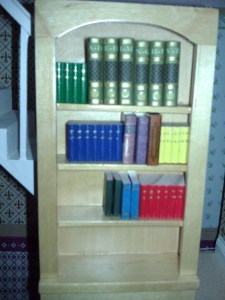
Some people take this third option a step further. I've seen lots of vendors at my visits to dolls' house fairs who specialise in creating miniature reproductions of actual books. So you can buy MOBY DICK or ALICE IN WONDERLAND, say, recreated in 1/12th scale. The words are too tiny to read, but if you peer at them with a magnifying glass, you will see that every word is present in these miniature recreations. They are incredible, but very expensive. Most of these vendors spend hours on their projects, and they are priced accordingly. You pay more for a tiny book than you do for a real-life sized one.
I have been painstakingly working on filling my doll's house book shelves with a combination of these three types of books (the 'real' ones have blank pages, which are much cheaper), and I attach a picture of the result so far. You can see that not all the shelves are full yet, but I am quite proud of it.
I learned from my doll's house club the secret to affixing the books on the shelves. The trick is something called 'Tacky Wax'. It is precisely what it says on the tin. You attach a tiny bit to the book, and put the book on the shelf. It will keep the books from flying all over the place if the house is knocked, but they are still easy to remove if you want to move them around.
Now I have to work on filling the second book shelf. And, of course, finishing the house so I can get on with the task of putting in the furniture.








January 6, 2012
My Life In Books: Amelia Jane
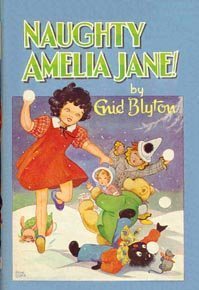 This one should have been on the list rather earlier, as I'm trying to do these books in roughly the order I read them in. I was quite young when I read these, but I'd forgotten all about them until recently.
This one should have been on the list rather earlier, as I'm trying to do these books in roughly the order I read them in. I was quite young when I read these, but I'd forgotten all about them until recently.
Amelia Jane was the protagonist in a series of books Enid Blyton wrote about the toys in a nursery that come to life when the humans are out of the room. Amelia Jane was a big rag doll who was always naughty, and bullied the other toys.
I must have been about four or five when I first discovered these books. They appealed to me because I liked to believe that my own toys came to life when I was asleep. Sometimes I would wake up in the morning convinced that some of my dolls were in a different place to where they had been when I went to sleep.
Like all Enid Blyton books, these books feature imaginative story lines with a strong moral lesson about the evils of being naughty and disobedient running through them. Amelia Jane's naughty behaviour always led to some form of punishment. It seems they are still in print, but I suspect they have been heavily amended since I was reading them over 35 years ago. The original books – published in the 1960s – featured a variety of toys as characters. One of them, as can be seen from the cover image, was a golliwog. These books were written in a less politically correct age. Golliwogs were actually still around in the 1970s, but they were banned rather a long time ago. Presumably the golliwog in the contemporary re-issued books has been replaced by a different character.
It's nice to know they are still available, but I wonder what modern children make of them. I suppose kids will always delight in stories about someone being naughty – that, at least, is a timeless entity.








January 4, 2012
Best Books of 2011
(Cross-posted from the WriteClub blog)
I have talked before about how much I like Goodreads. Not only is it a good platform for writers to promote their books, it's also a good way of keeping track of all the books you read. This time last year, I set myself a challenge to read 50 books in a year. The challenge only works, of course, if you are diligent about logging every book you read on Goodreads. This is not something I have a problem with – I am quite shameless about broadcasting my reading tastes to the world. Some folks, I suspect, will only log on Goodreads the books they want the world to know they're reading, but that's an entirely different story.
In any case, I have no shame and I am somewhat anally retentive about keeping track of my reading habits, so I find Goodreads rather handy. I read 55 books in 2011, so I exceeded my reading goal.
Because you can also rate books on Goodreads, it's fairly easy to pick out which ones you thought were the best. So I am presenting, in this post, my Top 5 Books of 2011. I will add a qualifier here, and say that these are from the perspective of books I read, not books that were published, in 2011. Some of them I have reviewed on Goodreads. Rather than repeat myself here, if this applies I have included the link in the title.
SISTER – Rosamund Lupton. A beautifully-written book about the grief of an older sister, trying to find the killer of her younger sister. Not exactly a cheerful read, but well worth a look if you're interested in the dynamics of family relationships.
NOW YOU SEE ME – SJ Bolton. This is a book I had to review for SHOTS, and it had me hooked. A gripping and genuinely spooky crime thriller that offers an interesting slant on the Jack the Ripper legend.
HEARTSTONE – C J Sansom. The quality of the writing in this series of historical crime novels blows everyone else out the water. Sansom's protagonist, hunchback lawyer Matthew Shardlake, investigates murders against the backdrop of Henry VIII's court. In this book Henry's wife is Catherine Parr, which possibly means, sadly, there won't be too many more in the series, unless Sansom plans to carry Shardlake through the aftermath of Henry's reign.
CHANGES – Jim Butcher. Harry Dresden, the only wizard in Chicago, inhabits a contemporary alternative world in which magic, vampires and faeries exist, with most humans being oblivious to this fact. Harry, a chivalrous and flawed character, can never resist coming to the rescue of a damsel in distress, and it is the voice of his character – brave; wise-cracking; resourceful – that make this such a fabulous series. Poor Harry has a hard time in this novel, and this is only one to read when you've already got the sequel in your TBR pile, because it ends on a cliff hanger.
THE HAUNTING OF HILL HOUSE – Shirley Jackson. I've wanted to read this since I saw the film adaptation (the original 1963 version – not the 1990s remake). It's classic gothic horror at its finest. Four people gather in a haunted house, as part of an experiment to study psychic phenonema. They all bring their own psychological baggage with them, and the way they interact with each other is as much part of the atmosphere as the ghostly goings on.
So there we have my Top 5 reads of 2011, and happily it represents a cross-section of the genres I read in.
With a degree of overconfidence, I have set myself a new target for 2012 – to read 60 books. It remains to be seen if I will succeed, but my TBR pile is big enough to give me plenty to be getting on with in the foreseeable future.








January 2, 2012
Monday's Friend: Julia Knight
Today I am pleased to welcome Julia Knight as my first guest of 2012. Julia successfully writes in several genres, and she's here to tell us how she does it.
The Difference Between Genres
By Julia Knight
No, not the difference in what they involve. The difference in writing them.
Usually I'm a fantasy girl through and through. I love the fact I can just make stuff up, and not have to worry about if it actually works that way here, on this planet. But last year, while conversing with my editor about edits for one of my fantasies, she mentioned that she thought I had a good voice for historical, had I thought about writing one? Two days later, I was in Norway and I suppose it was inevitable really. I wrote a book about Vikings. Which meant I had to do something I've had little cause to in my fantasies; research. And not 'research so the laws of physics are obeyed when my pirate fires his flintlock', or 'research to find out what happens during hypothermia'. Proper, 'this is what happened, how these people lived' research. And I had to make sure that I got my facts right. A daunting prospect, especially given that one of my characters is a good Catholic girl and what I knew about Catholicism could comfortably fit on the head of a pin. Get that wrong and, well, people quite rightly get upset.
Of course, I don't make it easy on myself. The book is set in the 9th century and there isn't exactly an extensive written, solid record for the period. There are details, and some very interesting ones, but while there are facts abounding, quite often they, or the experts, are contradictory. Would Vikings and Saxons have understood each other? Enough to have a proper conversation? Depends who you ask. So not only did I have to research, I had to choose which answers I believed. And make sure I didn't go off on too much link surfing. That was hard — I go to a site just to look up what say the Vikings ate and two hours later I'm reading about units of measurement in the early mediaeval period.
However, I did learn one very important thing — I like research, I learned some surprising things, such as how much freedom the women of that time really had, and it gave, I think, a greater depth to the story to be able to show the clash of cultures between how Saxons lived and worshipped, and how the Norse did.
In fact, I think I might do it again.
You can learn more about Julia Knight, her books and reviews, at http://juliaknight.co.uk, or follow her on twitter @Knight_Julia. THE VIKING'S SACRIFICE is now available as an ebook, from Amazon, and will soon be available as an audio book.











